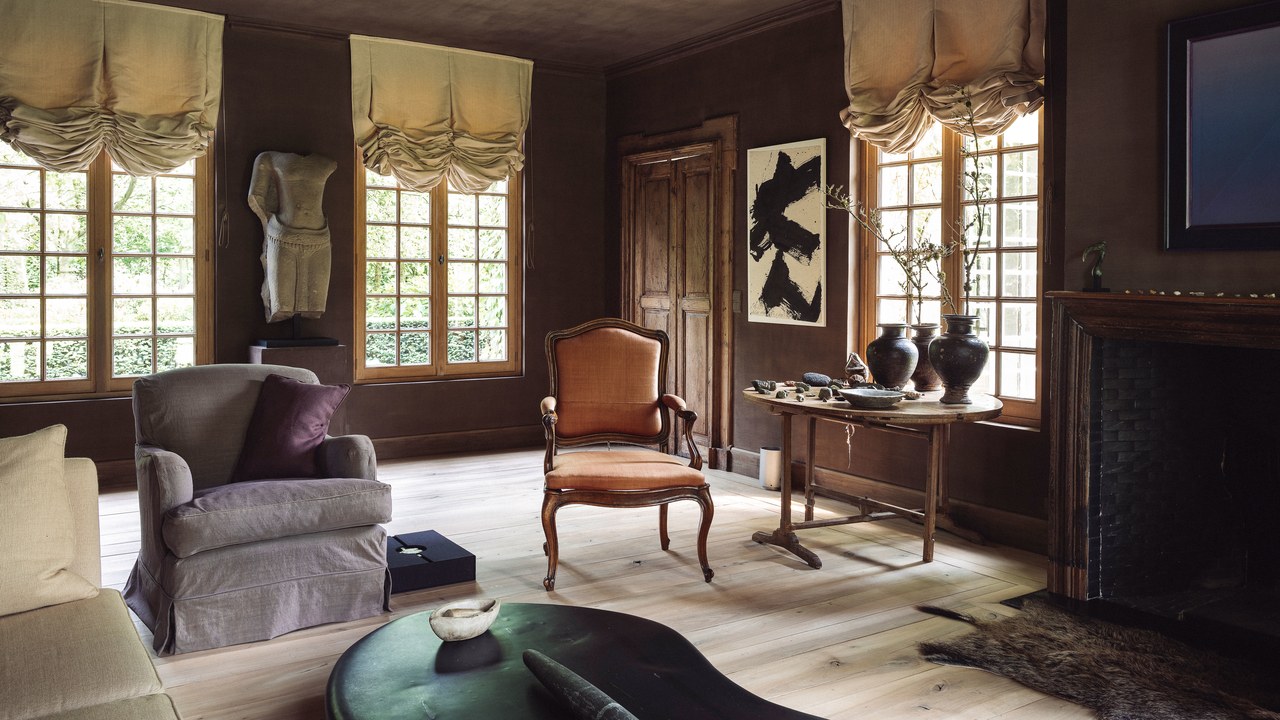A favourite Belgian house is master artisan Eddy Danker’s collaboration with Axel Vervoordt on his new home with an old soul that features moody pigments with a lot of depth, abstract art, a warm patina, neatly clipped hedges and rambling vines. Here’s a look at some of the elements to recreate the look. Including the #1 lesson for creating the inimitable understated Belgian aesthetic.
Eddy Dankers comes from a long line of royally appointed artisans: his ancestors were court painters for the royal families of England, Sweden, and Poland, and he has lent his own talents to the residences of the royal family of Belgium. But a taste for gilded finishes and rococo flourishes seems to have eluded him in his own home, an understated three-bedroom house in Nijlen, that he shares with his girlfriend, architect Julie Claes. Read more, ‘Why You Should Redecorate Until You Kick The Bucket.’
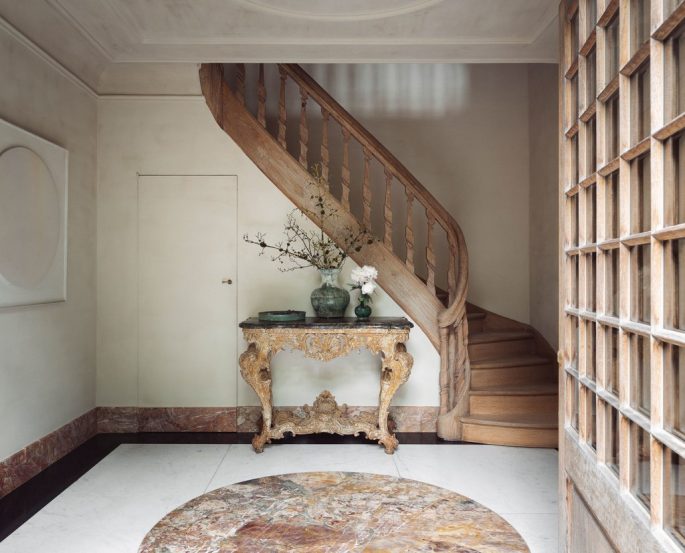
One of the first purchases for the house was the 18th-century stairway in the entry foyer, which was set aside for him by Axel Vervoordt early on in the construction phase.
1. Go Organic
“It’s very organic and humble, not imposing,” says the Belgian painter, who stumbled upon the property on a leisurely bike ride 30 years ago. “It looks like an 18th-century house with good Golden Rule proportions.”
2. Use lime techniques and mineral-based paints
In fact, it’s hard to believe the structure didn’t exist even as recently as 25 years ago. Designed by friend and longtime collaborator Axel Vervoordt, the house exudes soulfulness, a feat that comes as no surprise given the celebrated Belgian designer’s mastery of minimalist spaces with a sense of romanticism. But it is Dankers’s virtuosity in his family’s traditional painting practices and adherence to natural materials—ideas as old as time now made revolutionary—that gives the house the warm patina of age. Read more, ‘Australia’s Best Paint Colours Are.’
“Everything is painted with old lime techniques and mineral-based paints mixed with my own creativity,” says Dankers.
“The house was a canvas for me to try out pigments with a lot of depth.” He incorporated dirt from his father’s garden to create the earthy brown walls in the living room, and he hand-painted the cuir de Cordoba leather panelling in his office. A custom hue known as Dankers White, which his father taught him to make, covers the walls of the orangerie, the house’s summer living room. “Lime is the mother of all paints,” he says. “It’s nontoxic and very breathable. It feels very natural, like it’s always been there.” This patina draws us with a power that the shine of the new doesn’t possess.

“In the morning you get the most beautiful light,” says Dankers of the orangerie, which he uses as a summer living room and is covered in layers of his signature Dankers White lime paint. “It gives me a lot of energy to start the day.”
3. Collect antiques
A covetable collection of antique furnishings helps complete the timeworn look. Bringing old pieces into your life doesn’t require money, training, or special skills. It takes a mind quiet enough to appreciate muted beauty, courage not to fear imperfection, willingness to accept things as they are—without ornamentation. It depends on the ability to slow down, to shift the balance to appreciating rather than perfecting.
4. Salvage architectural elements
Danker’s first purchase for the house was the 18th-century stairway in the entry foyer, which was set aside for him by Vervoordt early on in the construction process; over the next four years, he added to that list antique doors and vintage tiles, aged wooden beams and stately columns, finishing the house room by room as finances allowed.
Old bricks for flooring will recreate the look of an ancient villa.
Reclaimed materials (stone or wood floors, old doors, fireplaces, bathtubs, windows, and fountains) with a history have a texture that are great to look at and live with.
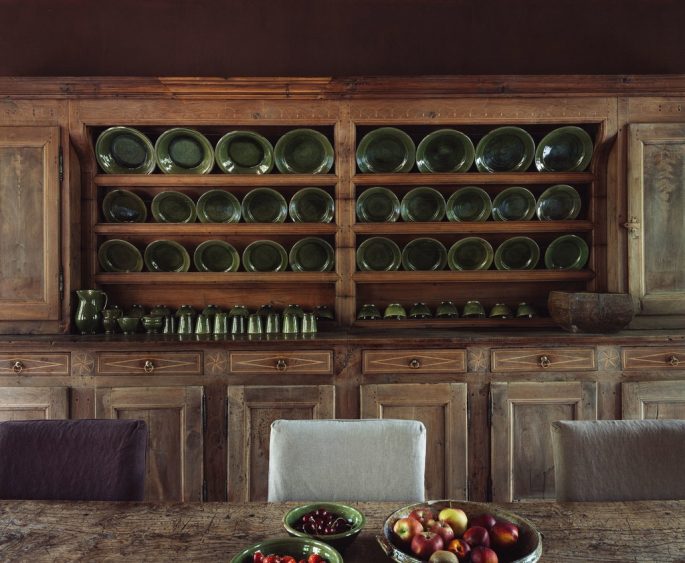
Dankers and his girlfriend, the architect Julie Claes, enjoy entertaining in their burgundy-coloured kitchen, which is dominated by an open fireplace and a custom sideboard that stores olive-hued Spanish dishes.
5. Use abstract art
The artwork, on the other hand, for the house leans toward the modern. Abstract pieces by artists Yun Hyong-keun, Sadaharu Horio, and Jef Verheyen lend the unassuming interiors a surrealist quality that continues in the garden thanks to the interplay of neatly clipped hedges and rambling vines, the work of the lauded late landscape designer Jacques Wirtz. “It’s like the house is embraced by all the green, and then the Japanese cherry trees in the back bloom in a cascade in the spring. It’s incredible.”
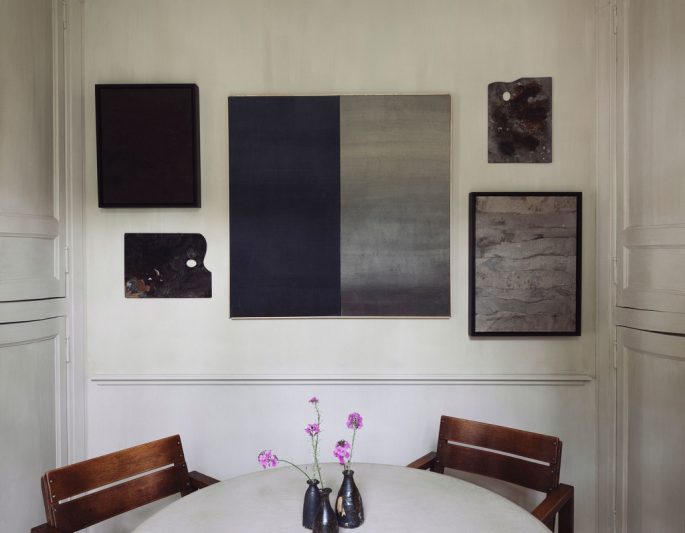
The former dining room has become what Dankers calls an “art room,” decorated with painter’s palettes that he and Claes created themselves as well as a custom painting he installed. “It’s a presentation of day and night, with the light blue representing a Flemish sky and the dark indigo symbolizing the night,” he says.
6. Moody Colours
There is definitely a painterly colour to everything that comes from Belgium. Black, grey or aubergine that are at once bold and easy to live with. Colours that are so rich, you’re compelled to touch the walls to feel it. Complex and bold saturated neutrals that exude a sense of groundedness and timeless chic. Hues that shift with the light. They also contrast wonderfully well with furniture indoors; outdoors they form the perfect backdrop with plants.
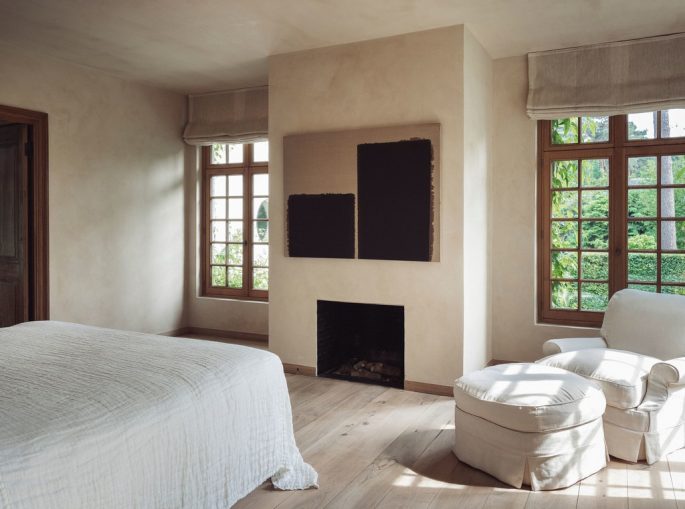
The master bedroom features abstract artwork by Korean artist Yun Hyong-keun and a neutral colour palette.
7. Go Natural
There’s a warm patina to almost every Belgian interior. It comes from the use of natural finishes such as linen curtains and bedding, cashmere for sofas add authenticity. Rough textures and materials in subtle hues don’t feel too perfect – and give an interior charm because there’s something a little bit off about them.
Consider the patina around a wooden bowl, a tarnished goblet.
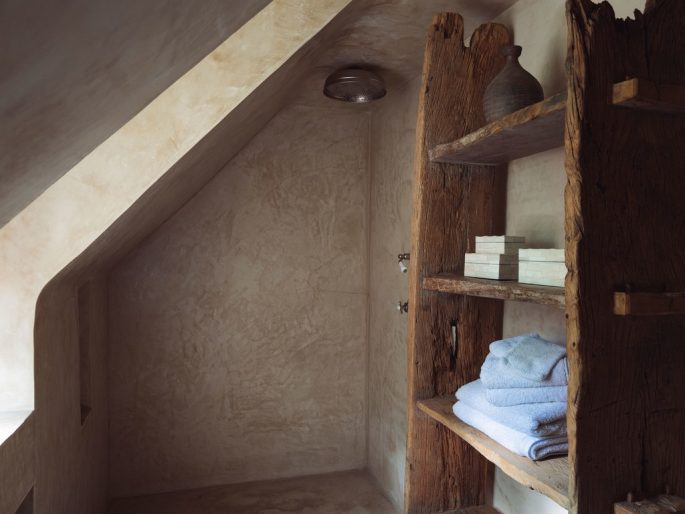
The second-floor guest bath is covered in tadalakt, a waterproof plaster used in Moroccan architecture.
8. Create a haven
A testament to the artistry on display at every level, the property itself has become a source of creativity for Dankers. Though the commute to his studio is just a five-minute ride, he feels like the house is a world away. Read more, ‘Improve Your Mood With These 50 Top Decorating Tips.’
“We don’t have a telephone here; we don’t have televisions,” he says. “I’m travelling so much that when I’m here I just want to relax.”
But work is never truly out of mind, as anyone who has seen the vast array of pigments available through his Domingue Architectural Finishes line of lime washes, mineral paints, and decorative plasters can attest.
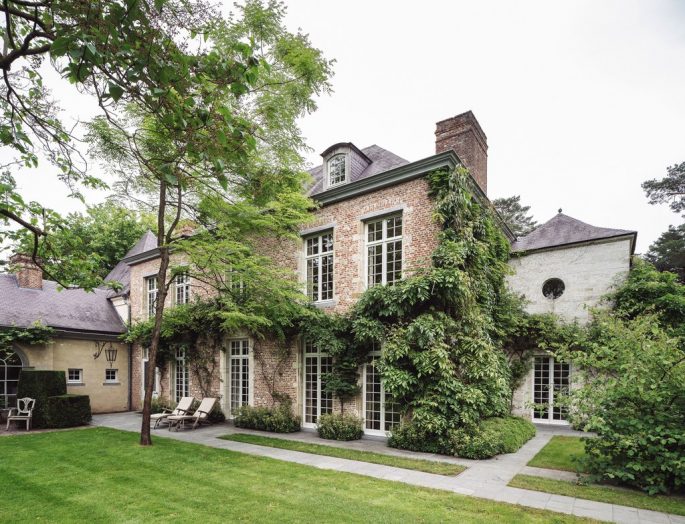
“In the spring the house is covered in beautiful blue flowers,” says Dankers of the wisteria vine that grows along the side.
9. Accept beauty in imperfection
Look for items from the back of a cupboard: a chipped vase, a faded piece of cloth, a ragged old basket. Look deeply for the minute details that give it character. Collect glazed stoneware handmade plates. Put them all on display. You don’t have to understand why you’re drawn to them, but you do have to accept them as they are.
10. Let Nature Inspire
“For me, nature takes on the role of inspiration,” Dankers says. “When you see the colours of plumage on the birds, the green of the herbs, the way the walls change like a chameleon in the orangerie with the light—everything can be inspiration.” He just happens to be at home in it where he uses the colour green as a backdrop in the garden. Dense foliage has the same effect as a velvet lining in a jewellery box. Everything else you plant will pop out like a diamond displayed on rich fabric. Read more, ‘Making A Modern Garden.’
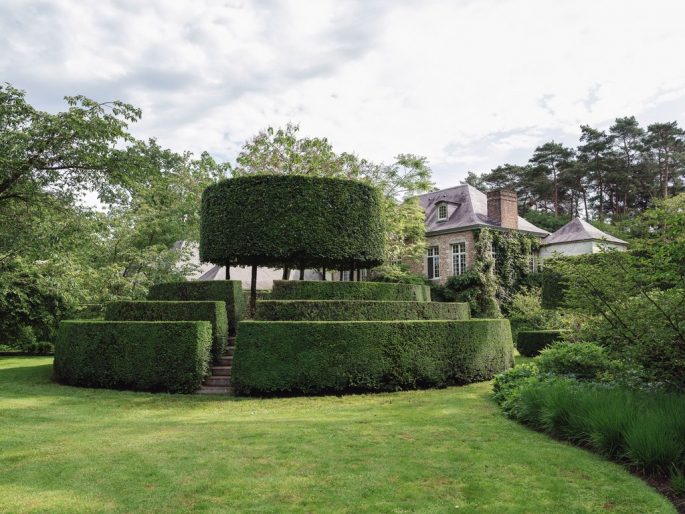
Neatly clipped edges force the eye over unsightly water pumps used for irrigation and other domestic needs.
11. Forgo Flowers
Flemish gardens often have austere, simple palettes of green on green with an emphasis on texture, shape, and size instead of bright colours or flowers. Evergreen shrubs have year-round appeal and can create a sense of symmetry and balance that makes seasonal flowering plants feel chaotic in comparison.
12. Use hedges for definition
In Belgium, where the terrain is a rolling flat expanse without natural features such as mountains or valleys, creating a relationship between a garden and the surrounding landscape can be difficult. As a solution, Belgian gardeners use hedges to create a distinct perimeter.
A hedge of green shrubs always looks better than a fence.
Planted at the edge of a garden, tall-growing shrubs such as boxwood, and laurel can be used to grow together to create a dense privacy screen that also absorbs and blocks noise from traffic and neighbours.
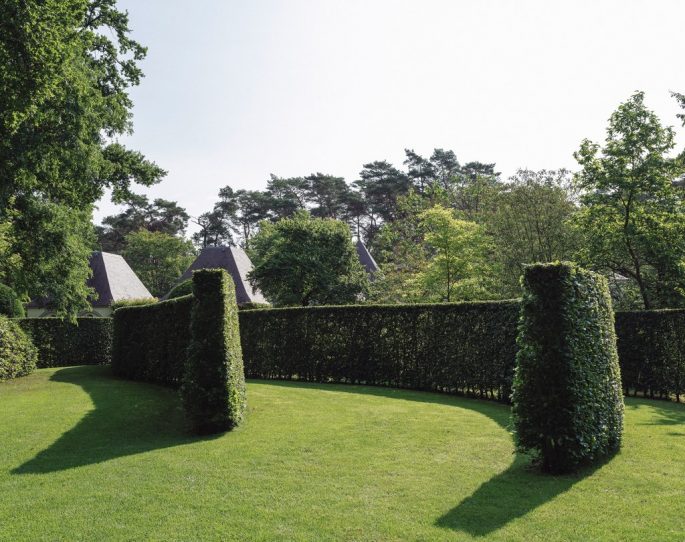
Celebrated Belgian landscape designer Jacques Wirtz designed the garden, with clipped hedges that provide contrast to romantic rambling vines and loosely arranged greenery.
The original excerpts of this story appeared in Architectural Digest.

